Climate disruption could aid spread of Amazon tapeworm disease

Outbreaks of a life-threatening disease caused by a tapeworm could be being driven by climate change and events such as El Niño, a new paper has found.
Published in the journal PNAS, the findings provide evidence of the impact of climate and environmental conditions on a neglected tropical disease in the Amazon region, with implications for other types of disease.
Although treatable, the disease, called polycystic echinococcosis, kills about 27% of those who contract it, a very high level of mortality, if it is not diagnosed in time. It enters the food chain through hunting a mammal called lowland paca (Cuniculus paca), a large rodent that is eaten by the local people and highly traded in wildlife markets across the whole Amazon region.
The study was led by the Barcelona Institute for Global Health (ISGlobal), an institution supported by "La Caixa" Foundation with contributions from University of Salford academics Hani R. El Bizri and Jean Boubli.
The parasite normally lives in animal reservoirs such as the lowland paca (intermediate host) and bush dogs (Speothos venaticus, definitive host). It can be transmitted to humans who handle infected animals, particularly pacas, or when the viscera of these animals containing cysts of the tapeworm are offered to domestic dogs after butchering, and then humans get infected after eating food contaminated with dog faeces containing tapeworm eggs. The worm affects especially the liver and lungs of the victim.
Xavier Rodó, ISGlobal researcher and one of the authors of the study said: “Polycystic echinococcosis is a good example of the many zoonotic diseases associated with the handling and consumption of wild meat. Understanding the role of climate in the emergence and spread of these zoonoses is becoming increasingly important, given the ongoing global warming scenario."
Hani Bizri, from the University of Salford, is an expert on pacas and aided the research, especially by providing large-scale data and insights related to the hunting of this species by local Amazonian communities. He said: “The paca is probably the most hunted species across the whole Amazon and potentially all Latin America, making the likelihood of being infected by this disease very high. That is why this paper is so important. If climate variations increase the rate of infections we could start to see this disease becoming more and more of a problem.”
In this study, the research team compiled two unique databases: one of PE infections in animals and humans covering the entire Amazon region (around 400 cases), and another one on hunting practices (containing almost 440,000 observations of animals hunted in 55 independent study areas in eight Amazonian countries, over the last 55 years). This allowed the authors to understand the spatial distribution of polycystic echinococcosis, and to investigate how the disease is influenced by ecological, environmental and climatic factors, as well as hunting patterns.
The analysis shows extreme climate events (such as El Niño) disrupt hunting patterns and potentially drive more human infections.
"This means that regional climate change due to global warming may indirectly drive disease outbreaks in humans," says Adrià San José, first author of the study. This also means that information on land use and climate projections could be useful for early warning of potential PE hotspots.”
These findings have clear implications for other similar hunting-related zoonoses. They also highlight the value of comprehensive databases for understanding the role of climate in the emergence and spread of zoonotic disease outbreaks.
For all press office enquiries please email communications@salford.ac.uk.
Share:
